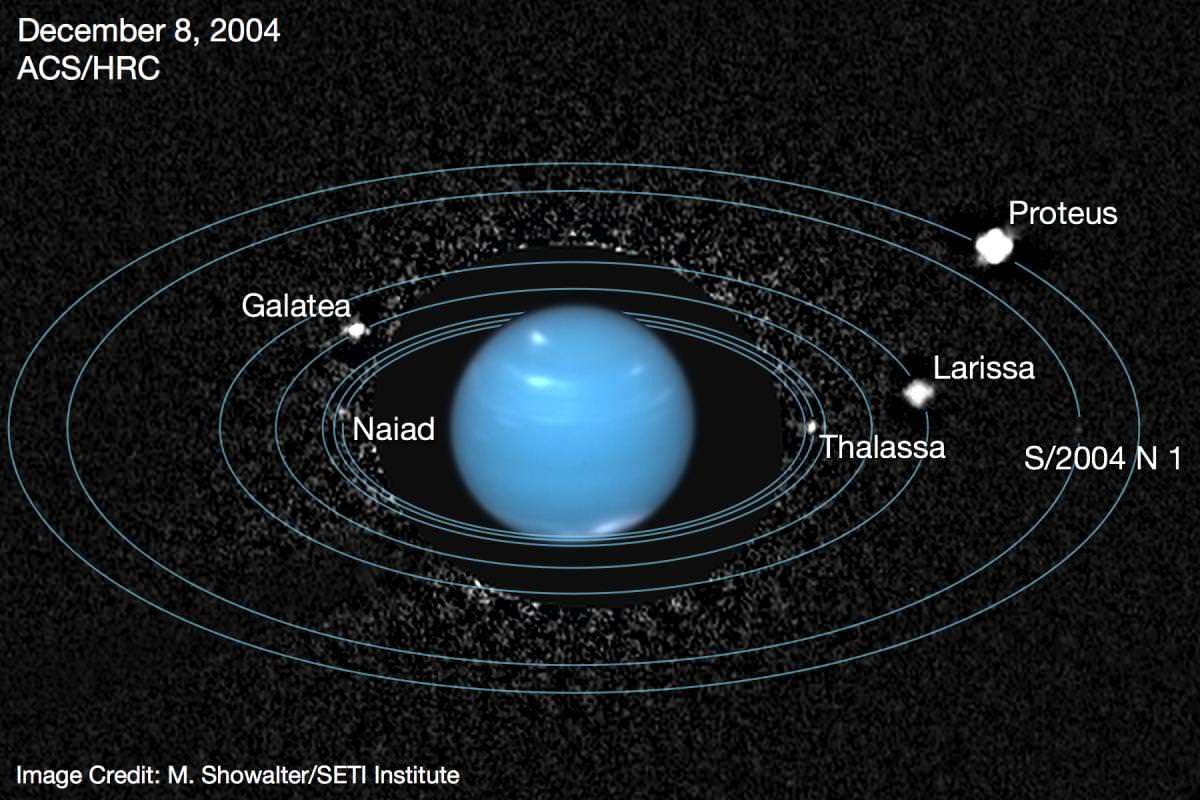Neptune is one of four planets in our Solar System with planetary rings. Neptune was not discovered until 1846 and its rings were only discovered definitively in 1989 by the Voyager 2 probe. Although the rings were not discovered until the late 1900’s, William Lassell who discovered Titan recorded that he had observed a ring. However, this was never confirmed. The first ring was actually discovered in 1968, but scientists were unable to determine if it was a complete ring. The Voyager’s evidence was the definitive proof for the existence of the rings.
Neptune has five rings: Galle, Le Verrier, Lassell, Arago, and Adams. Its rings were named after the astronomers who made an important discovery regarding the planet. The rings are composed of at least 20% dust with some of the rings containing as much as 70% dust; the rest of the material comprising the rings is small rocks. The planet’s rings are difficult to see because they are dark and vary in density and size. Astronomers think Neptune’s rings are young compared to the age of the planet, and that they were probably formed when one of Neptune’s moons was destroyed.
The Galle ring was named after Johann Gottfried Galle, the first person to see the planet using a telescope. It is the nearest of Neptune’s rings at 41,000–43,000 km. The La Verrier ring was named after the man who predicted Neptune’s position. Very narrow, this ring is only about 113 kilometers wide. The Lassell ring is the widest of Neptune’s rings. Named after William Lassell, it lies between 53,200 kilometers and 57,200 kilometers from Neptune, making it 4,000 kilometers wide. The Arago ring is 57,200 kilometers from the planet and less than 100 kilometers wide.
The outer ring, Adams, was named after John Couch Adams who is credited with the co-discovery of Neptune. Although the ring is narrow at only 35 kilometers wide, it is the most famous of the five due to its arcs. Adams’ arcs are areas where the material of the rings is grouped together in a clump. Although the Adams ring has five arcs, the three most famous ones are Liberty, Equality, and Fraternity. The arcs are the brightest parts of the rings and the first to be discovered. Scientists are unable to explain the existence of these arcs because according to the laws of motion they should distribute the material uniformly throughout the rings.
The rings of Neptune are very dark, and probably made of organic compounds that have been baked in the radiation of space. This is similar to the rings of Uranus, but very different to the icy rings around Saturn. They seem to contain a large quantity of micrometer-sized dust, similar in size to the particles in the rings of Jupiter.
It’s believed that the rings of Neptune are relatively young – much younger than the age of the Solar System, and much younger than the age of Uranus’ rings. They were probably created when one of Neptune’s inner moons got to close to the planet and was torn apart by gravity.
The innermost ring of Neptune orbits at a distance of 41,000 km from the planet, and extends to a width of 2,000 km. It’s named after Johann Gottfried Galle, the first person to see Neptune through a telescope. The next ring is the narrower LeVerrier ring, named after Neptune’s co-discoverer, Urbain Le Verrier. It’s only 113 km wide. Then comes the Lassell ring, the widest ring in the system at about 4,000 km. Then comes the Arago ring, and finally the very thin Adams ring, named after Neptune’s other co-discoverer.
We have written many articles about Neptune here at Universe Today. Here’s The Gas (and Ice) Giant Neptune, What is the Surface of Neptune Like?, 10 Interesting Facts About Neptune, and The Rings of Neptune.
If you’d like more information on Neptune, take a look at Hubblesite’s News Releases about Neptune, and here’s a link to NASA’s Solar System Exploration Guide to Neptune.
We have recorded an entire episode of Astronomy Cast just about Neptune. You can listen to it here, Episode 63: Neptune.

